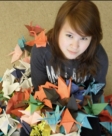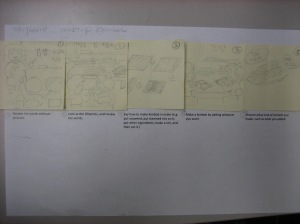Summary
Rolestorming: By pretending someone else, people may feel comfortable coming up with ideas from someone else’s perspective. I chose this brainstorming method because it would be good to create role-play activities. A teacher may print people, such as family members or people with various jobs, so that students can practice and develop their speaking and listening skills through a role-play activity using 3D objects. Thinking of “what you want to be (in class)” made me a little bit hesitant to create more ideas since it includes human being or animals. Maybe I could’ve included things, such as tables, chairs, etc. since children’s imagination is infinite.
Idea Trigger Method: This technique asks people to brainstorm ideas as many as possible and then select the best ones. People may trigger more ideas based on selected ones. It might be good to compile and classify ideas before getting more ideas. It was good for me to come up with ideas of how to use 3D prints in class in details; however, removing similar ideas might not be a good idea for class activities since teachers can always use the same idea in different ways.
Random Input: This requires people to pick a random word, picture, or sound from a dictionary, website, book, TV, etc. After selecting a word, we need to think how we can use it in a situation. It’s easy to come up with ideas since most of the words I selected were nouns, which can be easily made using 3D printer. However, main idea of using 3D print is students’ Korean learning, I was a little bit concerned if my idea was too much toward the activity class even though it is good for kids to learn Korean culture.
Reflection
Applying different brainstorming techniques enabled me to think usage of 3D objects in different ways, which are useful for teachers to develop their lessons. I used Rolestorming technique to create human beings who students may want to be. Trigger Method was helpful to get an idea of lesson plans. Random Input was the easiest one that I could come up with many ideas using 3D printer for teaching Korean language and culture. I wanted to use Bootlegging technique in a group because it was a good way to get creative ideas by mixing individual’s ideas. Unfortunately, I couldn’t even apply the other techniques with other people this time. I think brainstorming in a group always can create better ideas.
30 ideas
Rolestorming
- Mom – print a mom wearing a pretty cloth, such as a lacy dress with ribbons.
- Dad – print a dad with a casual clothes who is reading a newspaper.
- Sisters – print two sisters, which a student can play as an older sister. The student may say, “let me play with you.”
- Firefighter – print a firefighter wearing a uniform, which can play a role of getting on a fire truck and putting out the fire.
- Aunt – print a pretty aunt similar to a mom, which students can play as a nice aunt who always takes good care of them.
- Doctor – print a doctor with a stethoscope, which students can pretend as a doctor to take care of patients. The student may ask the patient “is something wrong with you?” “let me examine” using a stethoscope.
- Nurse – print a nurse with a uniform, which students can play a role by giving a shot to patients. The student may say to the patient “let me give you a shot.”
- Patient – print a patient with a bandage around his arm. The student may say to the doctor “my arm is broken.”
- Cook – print a cook with a uniform, which students can play as a cook. The student may say “let me cook for you” and fix the table.
- Artist – print an artist and printing materials, such as an easel, brush, and palette, which students can pretend as an artist.
Idea Trigger Method
- Ask students to write Korean letters (consonants and vowels) and print them out. And ask students to make words (e.g. their name, objects that they learned) using 3D prints
- Ask students select what they want to write about and print the objects. Ask students to write a short sentence(s) with a drawing and put a 3D object to their writing.
- Print Korean letters and ask students to make as many words as possible in groups within a certain time.
- Using the Korean letters printed, ask students to make words and attach them on the objects in the classroom.
- Print the objects that students learned in class and hide the objects in the playground. Ask students to find them.
- Print animals and use them in a puppet show in class.
- Discuss with students what we need to build a town. Print objects (e.g. houses, trees, cars, people, etc.) and have students build a town using those 3D objects.
- Have students draw their mailbox along with a symbol to be attached to the mailbox. Print them for students to use in class activities (e.g. put a letter in their friend’s mailbox).
- Using the letters, ask students to make words and put all the letters in their box. Have students to switch their box with their partner and have him/her make words and see what they make.
- Put the letters and the objects a little far away. In groups, have students come up with words relevant to what the teacher indicates (e.g. a ball for “round”). Ask students to use the letters and the objects over there and put as many objects or words on the paper.
Random Input
- Cup holder – for the folding paper class, print cup holders so that the students can put their paper cups to the cup holders.
- Tree – print a big tree or print small pieces to make a big tree. Have students make paper frames and put their name using 3D letter pieces on the frame. Have students decorate the 3D Christmas tree using their name frame.
- Flowerpot – for the folding paper class, print flower pots, leaves, and stems. Have students make paper flowers and complete the project of “Spring” using paper flowers and 3D objects.
- Picture frame – for the folding paper class, print picture frames with different shapes (e.g. rectangle, triangle, circle, etc.). Have students make paper birds, leaves, or flowers. Have them put those paper objects to the 3D picture frame.
- Lipstick – girls like to use their mom’s lipsticks. Print a lipstick and ask students how this looks like by eliciting the words about shape and color (e.g. long, red, etc.) Ask the student how she will be using this.
- Numbers – print numbers. Have students listen what the teacher is saying in Korean and have them answer putting the 3D numbers on their desk.
- Vegetables – print vegetables and give them to students. Have students say in Korean what vegetable they got and put them in their tray. Have students which vegetable they like or dislike.
- Clock – print clocks but print hour/minute hands separately. Have students put hour and minute hands by responding to what the teachers is telling about the time.
- Car and airplane – print several kinds of cars and airplanes. Have students choose what they like, and ask them to explain about their choice
- Kimbob (food like sushi) – print all ingredients of making Kimbob, such as, steamed rice, seaweed, ham, yellow pickled radish, egg, cucumber, spinach, etc. Have students simulate how to make Kimbob using those.
Evaluation method
Instead of selecting ideas by myself, I briefly presented all my ideas to a user and have her to select three. She chose four ideas, which include firefighter (Rolestorming), making letters as many as possible in groups (Idea Trigger), tree (Random Input), and Kimbob (Random Input). The reason she selected those was it could motivate students’ learning by letting them play using 3D prints. Since I had the same idea with her and I wanted to more focus on language education, I removed the idea of a tree, which is more good for the folding paper class.
Summary of initial user reactions
Since I couldn’t meet a teacher at Korean school, I asked one of my colleagues who is a Korean studying and working at UMBC. After selecting three ideas, we came up with more ideas from those three – Idea Trigger Method! For example, from the firefighter idea, we created more items related to this idea of rescuing people or animals, such as houses, water, a hose, fire trucks, and animals. Letters can be used very often in class by asking questions and having students making many letters or by letting them play in groups.
Among the three ideas, she liked the Kimbob (Korean food like a sushi) idea since visual objects can motivate students to learn all ingredients, create their own recipe, and play by using these 3D prints before they actually make Kimbob. The user also addressed that students can develop their numeral and spatial concepts since they are assembling pieces to create one.





